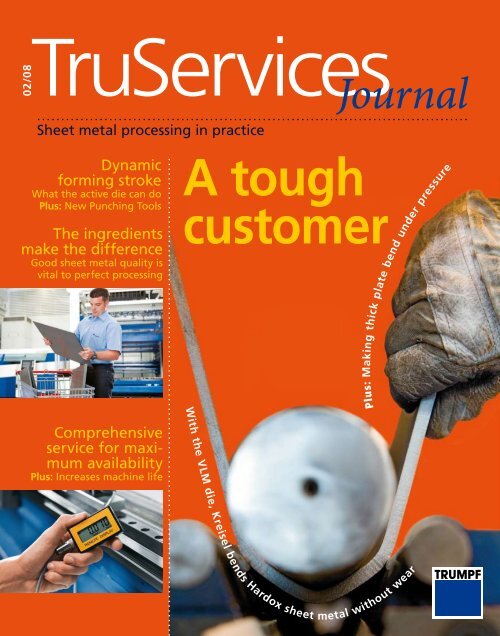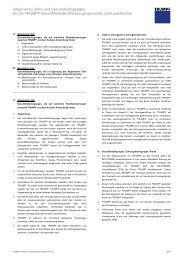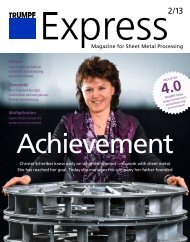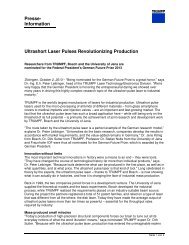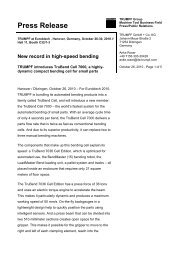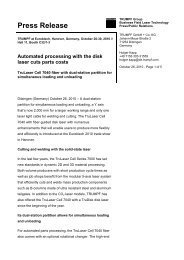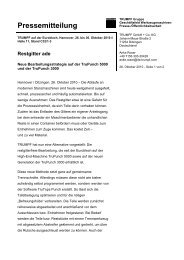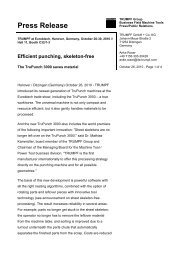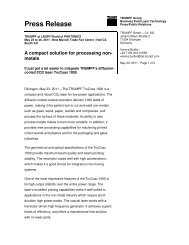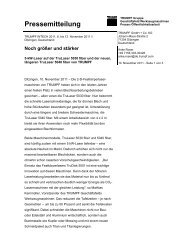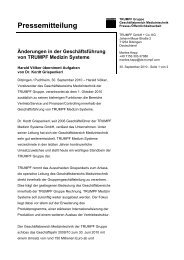Journal - Trumpf GmbH + Co. KG
Journal - Trumpf GmbH + Co. KG
Journal - Trumpf GmbH + Co. KG
Create successful ePaper yourself
Turn your PDF publications into a flip-book with our unique Google optimized e-Paper software.
02/08<br />
TruServices<br />
<strong>Journal</strong><br />
Sheet metal processing in practice<br />
Dynamic<br />
forming stroke<br />
What the active die can do<br />
Plus: New Punching Tools<br />
The ingredients<br />
make the difference<br />
Good sheet metal quality is<br />
vital to perfect processing<br />
<strong>Co</strong>mprehensive<br />
service for maximum<br />
availability<br />
Plus: Increases machine life<br />
A tough<br />
customer<br />
Plus: Making thick plate bend under pressure<br />
With the VLM die, Kreisel bends Hardox sheet metal without wear
<strong>Co</strong>ntents<br />
Technology<br />
In operation<br />
Technology news 4<br />
A tough customer<br />
Kreisel processes heavy plate 6<br />
May we have a word with you?<br />
Active die: Dynamic forming from below 10<br />
All at once<br />
CAD conversion in batch mode 11<br />
Optimally equipped<br />
Set-up parallel to operations made easy 11<br />
Knowledge<br />
The all-round, no worries package<br />
Maintenance, repair and part services 12<br />
More performance every day<br />
Product Enhancements boost productivity 15<br />
Always at the right angle<br />
The ACB sensor speeds up set up time 15<br />
Savings that can cost you<br />
Not all sheet metal plates are alike 16<br />
Good to know<br />
News about TruServices 18<br />
Quick reference<br />
Punching: Pages 10, 11, 15, 16<br />
Laser processing: Pages 11, 15, 16<br />
Bending: Pages 6, 11, 15, 16<br />
Management: Pages 12<br />
TruServices <strong>Journal</strong> 02/08 Sheet metal processing in practice<br />
Published by TRUMPF Werkzeugmaschinen <strong>GmbH</strong> + <strong>Co</strong>. <strong>KG</strong>,<br />
Johann-Maus-Str. 2, 71254 Ditzingen, +49 (0) 7156 303-0,<br />
www.trumpf.com, Responsible for the content: Dr. Gerhard Rübling<br />
Editor-in-chief Reinhold Groß, journal@de.trumpf.com Project<br />
coordination Katrin Oppermann <strong>Co</strong>nsulting Anke Roser, Press and<br />
PR, TRUMPF Editorial staff pr+co. gmbh, Stuttgart, Norbert Hiller,<br />
Julie Steinen, Monika Unkelbach Photos KD Busch, Udo Loster,<br />
Claus Langer Translation Stewart Lindemann, Wuppertal Design<br />
pr+co. gmbh, Stuttgart, Ute Vogt Reproduction Reprotechnik<br />
Herzog <strong>GmbH</strong>, Stuttgart Printing frechdruck <strong>GmbH</strong>, Stuttgart<br />
2 TruServices <strong>Journal</strong> 02|08<br />
Machine availability:<br />
The all-round,<br />
no worries package<br />
Professional maintenance and repair<br />
ensure long machine service lives.<br />
Page12<br />
CAD conversion:<br />
All at once<br />
TruTops <strong>Co</strong>nvert works in batch mode<br />
to translate CAD files into GEO<br />
format and takes all of the defaults<br />
into accout while doing so.<br />
Page11
Bending Hardox steel:<br />
A tough customer<br />
High-strength steel is tough — and<br />
that’s true during processing, too.<br />
But Kreisel has figured out the trick<br />
for bending and has created one<br />
more unique selling proposition. Page 6<br />
Retrofits:<br />
More performance every day<br />
Improvement needed? Producing efficiently and<br />
customized with functional Product Enhancements.<br />
Page15<br />
Sheet metal<br />
shopping:<br />
Savings that<br />
can cost you<br />
When can cost-cutting and<br />
cheap sheet metal actually<br />
increase users’ costs?<br />
Page16<br />
Editorial<br />
From the initial idea to the finished part. It might be simple<br />
enough to summarize the process chain used for sheet<br />
metal in just a few words. But it’s also true that every such<br />
chain is unique. Hardly any part is identical to the next, and<br />
ever smaller batches are being ordered, at ever shorter lead<br />
times. Here the customer usually specifies in advance how<br />
much a part is to cost. If we see the operations setting<br />
prevailing everywhere today as a challenge, then — for a<br />
company such as TRUMPF — customer orientation will<br />
always involve a high degree of flexibility and individuality.<br />
Let’s take applications consulting as an example. An<br />
experienced expert works out new sheet metal manufac-<br />
turing procedures on site, at the customer’s location. Such<br />
consulting normally results in improved work sequences,<br />
optimized programs and precise technology data. What is<br />
quite clearly in the foreground is helping clients help<br />
themselves, and that means imparting knowledge to the<br />
customer’s employees. In the concrete case it is a matter of<br />
using the production factors — material type, material<br />
consumption, time, machinery, programs and tooling — in<br />
an ideal way. It is by no means unusual for a re-engineered<br />
part to reduce production costs by as much as half.<br />
It is these individualized customer solutions that are the<br />
special tools used in the fields of punching and bending.<br />
Here tailor-made tools are created for our customers’<br />
specific application. Our engineers develop the tool<br />
specifications directly from the part drawings — custom<br />
made and very individual.<br />
Dr. Gerhard Rübling<br />
Managing Director for Services
In operation News<br />
Guaranteed function!<br />
4 TruServices <strong>Journal</strong> 02|08<br />
Freshly tapped from the water box<br />
// What the oil change is to the car — that’s what the water change is to<br />
the laser. But in contrast to engines, this change has to be made twice a<br />
year. Providing this quantity of water — 1,000 liters — is usually not so<br />
simple, particularly since handling large containers is difficult and water<br />
quality suffers during storage. That is why TRUMPF offers the “water<br />
box”. It makes up deionized water quickly, economically, in flawless<br />
quality. This unit is delivered with connector hoses and can be hooked<br />
up to the building’s water supply. With a water supply at normal hardness<br />
levels, it can produce almost 2,000 liters of deionized water. If customers<br />
have signed a maintenance contract with TRUMPF, then the service<br />
technician takes care of the water change.<br />
>> retrofit.tws@de.trumpf.com<br />
// Unpack, install, start. It is really as simple as it sounds. Bending<br />
Tools fabricated by TRUMPF are delivered<br />
with a function guarantee that reduces the<br />
user’s risk to zero. The technicians get<br />
involved right from the planning stage.<br />
Services include competent consulting<br />
either on the phone or on site and making<br />
up bending samples. The programming<br />
data for the machine controls are<br />
supplied with the tool, making installation<br />
a breeze. High demand has confirmed the<br />
value of the concept: At the end of September<br />
TRUMPF’s expanded production building in<br />
Pasching, Austria, was put into operation.<br />
>> abkantwerkzeuge@at.trumpf.com<br />
A U-shaped part manufactured in<br />
a single step thanks to a customengineered<br />
Bending Tool
A bag of tricks<br />
Grounding lugs in<br />
one clamping<br />
Michael Berger,<br />
expert for<br />
punching<br />
In many cases grounding lugs are<br />
pressed, welded or riveted, and that<br />
requires additional processing steps or<br />
touch-up work. The new five-fold<br />
multi-tool shows how different the<br />
situation can be when clamping is<br />
used. It is equipped with three punching<br />
inserts, an embossing insert and a<br />
reshaping insert to raise the plate,<br />
making for economical production of<br />
the grounding lugs. Three different<br />
dimensions can be made up with just<br />
a single change of tool position.<br />
Numerous applications will be found<br />
in the electronic industry and in<br />
mechanical and plant engineering.<br />
New and rugged cylindrical boot for the TruLaser Series 3000<br />
Laser chamfering for easier handling<br />
// In the past, laser-cut edges were available<br />
only with hard, 90° corners. Handling is made<br />
simpler and safer with rounded corners —<br />
facilitating insertion in assembly openings, for<br />
example. And making that improvement is<br />
quite simple, starting right now. The TruMatic<br />
7000 can now be used to finish laser-cut edges<br />
with an angle — or chamfer — on both<br />
sides. This is accomplished quickly,<br />
without touch-up work on a grinding<br />
machine, without changing the laser cutting<br />
parameters, and very quietly, as well. To<br />
do this, a groove with a root angle of 120° is<br />
first cut into the sheet metal. The laser beam,<br />
// Where a parts flap or disposal through<br />
the laser mounting console reaches its<br />
limits, that’s where the new MultiTool<br />
ejector unit simplifies the removal of<br />
small, laser-cut sheet metal parts with<br />
complex geometries. Application for a<br />
utility patent has been submitted for<br />
this new tool, intended for use with<br />
TRUMPF combination punching and<br />
laser cutting machines. It separates<br />
microjoints and ejects parts reliably<br />
through the die and into the waste container.<br />
The upper tool can be fitted with<br />
round or square cutting tools to match<br />
aimed at the bottom of the groove, cuts<br />
through the sheet metal. The result: a perfectly<br />
chamfered, laser-cut edge.<br />
>> truservices@de.trumpf.com<br />
MultiTool ejector for combination machines<br />
every part geometry. This<br />
makes it possible to produce<br />
both round and<br />
straight contours without<br />
having to change tools.<br />
The new MultiTool<br />
ejector is especially<br />
useful<br />
with parts featuring<br />
small<br />
and complex<br />
laser contours.<br />
Chamfered laser-cut edges<br />
for smoother handling<br />
>> technik.tooling@de.trumpf.com<br />
Armor for the laser beam<br />
MultiTool for simple<br />
displacement of scrap<br />
// A laser beam might be as strong as Hercules, but it does have an<br />
Achilles’ heel: It is susceptible to the effects of dirt particles as it<br />
passes among moving machinery components. Beginning this fall,<br />
the TruLaser Series 3000 is equipped with the shielding — previously<br />
available only for the Series 5000 — needed to eliminate this<br />
critical problem. The newly developed cylindrical boot offers two<br />
innovations at once. Its rounded shape eliminates holes at corners<br />
resulting from material fatigue while the new, injection-molded<br />
plastic material is significantly more rugged.<br />
>> retrofit.tws@de.trumpf.com<br />
TruServices <strong>Journal</strong> 02|08 5
Bending Hardox steel is a real challenge<br />
— and a specialty for the Kreisel company.<br />
6 TruServices <strong>Journal</strong> 02|08
A tough<br />
customer<br />
Hardox steel is made to<br />
withstand the most extreme<br />
wear. But this is a quality that,<br />
unfortunately, also comes into<br />
play during processing. Thanks<br />
to the VLM die, the Kreisel<br />
<strong>GmbH</strong> & <strong>Co</strong>. <strong>KG</strong> can bend high-<br />
strength sheet metal as thick as<br />
eight millimeters without major<br />
wear. And when doing so, it<br />
reduces the time required for<br />
bending by two-thirds.<br />
Hardness paired with great toughness —<br />
that’s what makes Hardox steel the preferred<br />
material for the most demanding applications.<br />
But what reduces wear in the final<br />
products — such as dump truck bodies or in<br />
bulk goods handling equipment — can have<br />
unintended and less desirable effects during<br />
machining and manufacture. General Manager<br />
Horst Meister of Kreisel <strong>GmbH</strong> & <strong>Co</strong>.<br />
<strong>KG</strong> knows what he’s talking about.<br />
<strong>Co</strong>nveying bulk goods<br />
takes its toll This family firm,<br />
located in the town of Krauschwitz, near the<br />
Polish border, specializes in products used<br />
in environmentally sound dust reduction<br />
and conveyors for hard-to-handle bulk<br />
goods. One example is a rotary feeder.<br />
Whether it’s a matter of moving cement, fertilizer<br />
or sugar — in China, Vietnam, Russia,<br />
Poland or Germany — the rotary feeders<br />
Technology: Bending<br />
made by Kreisel ensure that the right quantity<br />
of material is introduced to the process<br />
at just the right time. This feeder essentially<br />
is comprised of a rotor to which trough-like<br />
chambers are mounted and which rotates in<br />
a closed housing. The bulk product falls<br />
into one of the chambers through the inlet<br />
opening and exits the chamber at the outlet<br />
port. This enables continuous feed at a specific<br />
volume. But, the insides of the troughs<br />
are exposed to severe loading by the material<br />
— such as cement clinker or lumps of<br />
coal in power plants. Material at a grain size<br />
of up to 150 millimeters is moved through<br />
the rotary feeders.<br />
Horst Meister: “That is the reason for the<br />
high demand for these feeders, particularly in<br />
the building materials industry and in coal<br />
feeding for power plants. This is where the<br />
Hardox material is important to us.” Hardox<br />
plate is used for these chambers and other<br />
Maik Lehmann works with the TrumaBend 320 to shape, in several steps, the material used for the chambers in the rotary feeders.<br />
TruServices <strong>Journal</strong> 02|08 7
Kreisel processes about five tons<br />
of Hardox steel each month.<br />
8 TruServices <strong>Journal</strong> 02|08<br />
Horst Meister, graduate engineer and general manager at Kreisel (left), and<br />
Detlef Roitsch, production manager, know when hard steel will yield under pressure.<br />
components. Of the 60 to 70 tons of steel that<br />
Kreisel processes each month, five to ten percent<br />
is Hardox material. When making up the<br />
individual chambers for these feeders they are<br />
bent into the trough-like shape in several<br />
steps at a TrumaBend 320. Meister says: “It<br />
was this machine that made it at all possible to<br />
bend thicker plate — at up to 20 millimeters.”<br />
Wear had become too<br />
costly “Initially we used standard dies<br />
to bend the Hardox plates. This process<br />
does not, however, comply with the recommendations<br />
published by the manufacturer<br />
of the material. As a result, fissuring and<br />
other blemishes appeared during bending.<br />
And above all, the dies themselves showed<br />
extreme wear,” reports Horst Meister. It<br />
must be remembered that the offset yield<br />
point is five times that of “normal” tool<br />
steel. With the Hardox 450 material, for<br />
example, this value is about 1,200 MPa at<br />
guaranteed hardness range of from 425 to<br />
475 HB. Maik Lehmann, who operates the<br />
press brake at Kreisel, experiences this time<br />
and time again. “The material is amazingly<br />
springy. I have to bend ten or twelve degrees<br />
beyond what is necessary for standard plate.”<br />
All in all, the load exerted on the dies by the<br />
high-strength steel was so great that they<br />
had to be replaced after bending about 100<br />
Hardox plates. Detlef Roitsch, production<br />
manager at Kreisel: “Initially the number of<br />
units we turned out were not high enough to<br />
justify the special, roller-equipped dies recommended<br />
by the sheet metal manufacturer.<br />
But, demand for our wear-resistant versions<br />
rose to the point that we ultimately had to<br />
find a solution.”<br />
Dies for maximum hardness<br />
levels Those were found in the<br />
VLM die made by TRUMPF, developed especially<br />
for bending thick plate while it<br />
is held in position. The user<br />
of rotating, hardened rollers<br />
reduces the press force<br />
required, avoids impres-<br />
In 2008, Kreisel was recognized<br />
with the “Saxon environment<br />
award” for the<br />
development of ecofriendly<br />
technologies.
sions and damage to the sheet metal, and<br />
reduces the wear at the die itself. Various<br />
swage widths can, in addition, be set up simply<br />
by shifting the jaws. The VLM die is available<br />
in two versions, for maximum load levels<br />
of 1,250 kN/m and 2,000 kN/m.<br />
Initial testing for the die at Kreisel was<br />
promising, but the rollers ultimately proved<br />
to be too soft. The edges of the Hardox<br />
plate scored them. Production manager<br />
Roitsch: “TRUMPF responded to the problem<br />
quickly and with flexibility. We received<br />
— gratis — a new set of rollers that were significantly<br />
harder.”<br />
Savings in many respects<br />
With these “extra tough” rollers, bending progressed<br />
without problems. Not only was wear<br />
minimized, but by working with TRUMPF<br />
engineers and based on the new die, Kreisel<br />
developed a new bending technique in which<br />
the number of bends could be reduced from<br />
five to three. Roitsch notes : “Today we need<br />
only ten minutes per bending cycle, compared<br />
with thirty in the past.”<br />
The VLM die has been in use for about a<br />
year, some 700 plates have been bent so far,<br />
all eight millimeters thick and in lengths of<br />
between 630 and 1,400 millimeters. Machine<br />
operator Maik Lehmann summarizes his<br />
experience at the press brake this way: “We<br />
can shape the plates faster but, in spite of<br />
this, no fissures appear. And we have not yet<br />
seen any wear at the rollers.” Detlef Roitsch<br />
sums up from the business administration<br />
viewpoint: “The VLM die costs a bit more<br />
than a standard die but, the higher price has<br />
quickly amortized itself. You see, processing<br />
Hardox plate has become a unique selling<br />
proposition for us.”<br />
>> abkantwerkzeuge@at.trumpf.com<br />
The Kreisel company was<br />
founded in 1912 as a metalworking<br />
and autogenous welding<br />
shop. In 1972, the company<br />
was nationalized by the East<br />
German government and reorganized<br />
as the VEB Entstaubungstechnik<br />
Krauschwitz, a<br />
part of the State Holding <strong>Co</strong>mpany<br />
for Ventilation and Refrigeration<br />
Technology in Dresden.<br />
Following German unification,<br />
the company, with its 80<br />
employees, was reprivatized on<br />
July 1, 1992. Today employing a<br />
staff of about 100, the company<br />
manufactures conveyor equipment,<br />
dust extraction equipment,<br />
pressure vessels and heat<br />
exchangers for the construction<br />
materials, foods, chemical, coal,<br />
potassium and glass industries.<br />
Technology: Bending<br />
The rotating, hardened rollers in the VLM die regulate press force and are easy on the material.<br />
The Hardox plates are highly resilient<br />
during bending and have to be “overbent”<br />
by twelve degrees.<br />
TruServices <strong>Journal</strong> 02|08 9
Technology: Punching<br />
A movable extra<br />
The new machine option<br />
“active die” is installed beneath<br />
the worktable and<br />
adjustable in height:<br />
• scratch-free sheet<br />
metal processing<br />
• an active forming<br />
stroke from below<br />
• larger area reforming<br />
with the use of new and<br />
bigger forming tools<br />
• simple programming<br />
The active die is an option<br />
that may be used with<br />
the TruPunch 5000 (starting<br />
from serial number<br />
S06.00) and the TruMatic<br />
7000 (starting from serial<br />
number S02.00).<br />
Michael Berger, technician<br />
for Punching Tools,<br />
explains what the active<br />
die makes possible.<br />
10 TruServices <strong>Journal</strong> 02|08<br />
May we have a word with you, Mr. Berger?<br />
Active die<br />
The active die promises new dimensions in forming.<br />
Is that promise justified?<br />
Michael Berger: The die mount is movable and executes an active forming<br />
stroke from below. That opens up possibilities that were hard to achieve in<br />
the past. We can set out on entirely new paths in regard to the machining<br />
strategy or tool concepts.<br />
Which new solutions can you offer?<br />
Berger: The active die enables larger and deeper forming. The fact that it<br />
can be lowered opens up more space. What’s more, we can employ entirely<br />
new tools in dimensions that were inconceivable in the past. We developed<br />
one tool, for example, with an extrusion of 60 millimeters in diameter. In<br />
other forming operations, as well, such as cups and bendings, we can capitalize<br />
on these advantages.<br />
Are there other changes in the tools?<br />
Berger: The space we gained by lowering the die makes it possible to install<br />
extras in the tool, such as more pressure springs. The extrusion tool, for<br />
example, has been fitted with a completely new packet of pressure springs<br />
and that’s the real attraction in that tool. What’s more, the extrusion distance<br />
is greater than in previous models, making forming possible at<br />
depths of up to ten millimeters. Thanks to the springs, the sheet metal<br />
remains relatively flat during forming. Existing tools can also be used on<br />
the new machines, fitted with the active die, without problems.<br />
What benefits can users expect as well?<br />
Berger: One major advantage is that the die makes scratch-free<br />
punching and forming possible without requiring accessories<br />
such as coated ejectors. The die can be lowered during<br />
processing so that it does not touch the workpiece<br />
at all. This also simplifies programming since the<br />
die no longer represents a hindrance that has to<br />
be “programmed around” when removing the<br />
part. It also makes better utilization of material<br />
possible and that saves costs.<br />
How does that work?<br />
Berger: Since the sheet metal is no longer<br />
lifted by the tool but, instead lays flat<br />
against the die, the customer can use the<br />
forming tools closer to the holding clamps.<br />
That reduces scrap and lowers material costs.<br />
>> technik.tooling@de.trumpf.com
All at once<br />
TruTops <strong>Co</strong>nvert calculates CAD files in batches<br />
// CAD software simplifies design and helps<br />
create drawings accurate down to tenths of a<br />
millimeter. But, there are a lot of different<br />
programs and it is often necessary to bring<br />
data to a common denominator in order to<br />
start production. This can be done manually,<br />
of course. The file will have to be<br />
loaded, edited and saved as a GEO file to<br />
interface with the TruTops programming<br />
system. TruTops <strong>Co</strong>nvert is a significant<br />
time saver because it executes this translation<br />
work automatically. Several CAD files<br />
in a given format can be converted and<br />
stored in batch runs. Bothersome manual<br />
editing is eliminated.<br />
Users of the TruTops programming systems<br />
will find this converter in the<br />
TRUMPF software package. With an additional<br />
license, this translation tool can be<br />
used parallel to the TruTops basic program<br />
— at a second workplace, for example. To do<br />
this, the files to be converted are stored in a<br />
transfer directory. TruTops <strong>Co</strong>nvert directly<br />
accesses this directory and transforms the<br />
Christoph Heissel shows how setup is<br />
simplified with the QuickLoad option.<br />
Technology: Software and tools<br />
data into the required<br />
format. The program<br />
can be installed for<br />
batch mode operation<br />
and can then<br />
convert data continuously.<br />
The GEO files<br />
generated will be<br />
saved in the same<br />
directory or in a different<br />
location specified<br />
by the user.<br />
Default settings can<br />
also be taken into<br />
account automatically,<br />
for all of the<br />
files, during conversion.<br />
Specifications for contour processing,<br />
zeroing and layer setting for drawings on<br />
several levels only need to be entered once.<br />
And that leaves just one question: Why don’t<br />
we simply do this all at once ?<br />
>> sales_CAD_CAM@de.trumpf.com<br />
Optimally equipped<br />
// To be at a standstill is never good, and<br />
most certainly not in production operations.<br />
If a machine has to be shut down to get it<br />
ready for the next operation, then capacity<br />
is underused — and that costs money. The<br />
tool system used in TRUMPF punching and<br />
nibbling machines makes it possible to set<br />
up tooling in parallel to the main operation<br />
cycle. Setup is made even simpler with the<br />
QuickLoad tool cartridge loading unit. It<br />
supports the operator by safely inserting<br />
punches, dies and strippers into the tool<br />
When running in batch mode,<br />
TruTops <strong>Co</strong>nvert takes<br />
into account all of the CAD<br />
default specifications.<br />
QuickLoad makes long setup times a thing of the past<br />
cartridge. It removes them too, without difficulty<br />
or additional accessories. In practice<br />
this means fast and easy setup. And that is<br />
also easy on the tools themselves. It is all<br />
done without excessive effort because<br />
QuickLoad is supported by a pneumatic<br />
unlocking system. This practical help can<br />
be used in tool cartridges fitting the current<br />
line of TruPunch and TruMatic machines.<br />
>> info@de.trumpf.com<br />
TruServices <strong>Journal</strong> 02|08 11
The TRUMPF<br />
spare parts<br />
service keeps<br />
30,000 items<br />
in stock.<br />
Knowledge: Maintenance and repair<br />
12 TruServices <strong>Journal</strong> 02|08<br />
The all-round,<br />
no worries package<br />
Four TRUMPF services offer professional maintenance<br />
and repair. They all know that prevention pays off.<br />
// When you purchase a TRUMPF machine,<br />
you are actually making a statement about<br />
your own quality and productivity goals. It is<br />
clear that buyers will be interested in having<br />
the machine available for as long as possible,<br />
with the least number of interruptions. Ultimately,<br />
the user is looking for a trouble-free<br />
manufacturing process and workpieces of<br />
uniform quality. Several TRUMPF services<br />
are designed to keep the machine and its performance<br />
“like new”: Service Agreements,<br />
Customer Training, Spare Parts and Technical<br />
Service are the pillars of maximum machine<br />
availability — throughout the service life.<br />
Better maintained: the Service<br />
Agreements TRUMPF service<br />
contracts cover maintenance work to be<br />
performed at intervals of six months and<br />
longer. A TRUMPF service technician plans<br />
and completes routine, preventive maintenance.<br />
All of the mechanical, pneumatic and<br />
hydraulic functions are inspected and<br />
adjusted. You can count on the fact that the<br />
work will be performed according to the<br />
TRUMPF maintenance checklist and documented<br />
with a maintenance sticker — the<br />
manufacturer’s confirmation of a machine<br />
maintained “by the book”. That’s service that<br />
will convince users based on output and<br />
value retention. The effort will pay returns<br />
once again when the unit is sold. Additional<br />
advantages: Preventive maintenance can be<br />
planned and integrated into the production<br />
schedule. It helps recognize the potential for<br />
interruptions due to wear and tear. That<br />
reduces downtime and its associated costs.<br />
It is a question of knowing<br />
how : Customer Training In<br />
addition to information on programming and<br />
operating TRUMPF products, maintenance is<br />
an important topic in the TRUMPF training<br />
curriculum. Participants in maintenance<br />
courses learn how to complete some of the<br />
recurring maintenance<br />
tasks on their<br />
own. In addition to<br />
the classic cleaning<br />
work, this includes,<br />
for example, replacing<br />
filters and changing<br />
oil and water.<br />
Training also covers<br />
inspecting drive components<br />
and the<br />
external appearance<br />
and reference points.<br />
These are tasks essential<br />
to uninterrupted<br />
machine availability and should be learned.<br />
Practical experience means more safety for<br />
user and machine. A certificate attests to successful<br />
completion of the course, which is tailored<br />
to the particular machine model. With<br />
the knowledge gained about the machine’s<br />
component groups, the trainee becomes an<br />
even more competent source of information<br />
for the TRUMPF technical service department<br />
— just in case something should ever go wrong.<br />
TRUMPF Service<br />
Agreements offer<br />
maintenance you<br />
can depend on.
Genuine parts: the spare<br />
parts service Whenever it becomes<br />
necessary to replace parts or make a repair,<br />
fast and punctual delivery are worth real<br />
money. Sometimes the availability of a spare<br />
part is equivalent to the availability of the<br />
machine itself. Here every minute counts<br />
and, ultimately, a well-stocked warehouse is<br />
essential. That is something you can be sure<br />
of here because every part that has been<br />
ordered more than twice is on hand, and<br />
that includes spares for older machines. The<br />
total count is more than 30,000 items — all<br />
of superb TRUMPF quality and perfectly<br />
matched to the machine. They are all original<br />
parts. Additional advantages offered by<br />
spare parts service include 24/7 order and<br />
shipping service within Europe, a generous<br />
returns policy and equally liberal terms for<br />
credit notes — on many parts for even as<br />
long as four years after purchase.<br />
Helpful: the Technical Service<br />
If defects are detected during operation or<br />
maintenance work, then it’s time for<br />
TRUMPF Technical Service to get to work.<br />
It is comprised of highly competent office<br />
staff and a close-knit network of field service<br />
technicians. A first step in the analysis<br />
is often “Teleservice”, offering optimal support<br />
for quick fault rectification. The remote<br />
service system can — with the customer’s<br />
approval — access machine data through a<br />
modem and then remote diagnosis begins.<br />
It is not unusual for this to be the first step<br />
ANDREu CuLuBRET,<br />
SHOP FOREMAN<br />
LASER DEPT. AT OXITER:<br />
“Having the manufacturer handle<br />
machine maintenance is the ideal<br />
situation. This helps avoid breakdowns<br />
since the technician can<br />
spot impending problems in good<br />
time. In addition, we benefit<br />
from professional, on-site consulting<br />
whenever it’s necessary to<br />
order spare parts.”<br />
Oxiter Girona S.L., Girona, Spain,<br />
founded in 1972, 80 employees,<br />
www.oxiter.com.<br />
Job-shop operations in 2-D cutting of mild<br />
steel, stainless steel and nonferrous metals<br />
Problem-solving<br />
— from remote<br />
maintenance to<br />
“house calls”— is<br />
the task of the<br />
technical service<br />
department.<br />
TruServices <strong>Journal</strong> 02|08 13
Knowledge: Maintenance and repair<br />
LoTHAR WEBER,<br />
OPERATIONS MANAGER,<br />
H. P. KAYSSER:<br />
“Working closely with TRUMPF’s technical<br />
staff, 80 percent of all ‘house calls’<br />
can be avoided from the very beginning.<br />
That is the quickest solution.<br />
What I like best is that the TRUMPF<br />
technician diagnosis errors while we’re<br />
on the phone, using remote “Teleservice”.<br />
The next morning a package of<br />
spare parts arrives and the problem is<br />
solved. Waiting for the technician is<br />
completely eliminated.”<br />
H.P. Kaysser, Leutenbach Nellmersbach, Germany,<br />
founded in 1947, staff of 360, www.kaysser.de.<br />
CNC sheet metal technologies,<br />
fine-gauge sheet metal, robotic welding and<br />
connection technologies, laser welding,<br />
3-D cutting, laser labeling.<br />
14 TruServices <strong>Journal</strong> 02|08<br />
toward eliminating the problem. Often production<br />
can be resumed once the phone call<br />
is completed. If this proves to be insufficient,<br />
then more than one thousand service technicians<br />
are on call to repair the machine.<br />
They have years of experience and are all<br />
trained centrally at the TRUMPF Training<br />
Center in Ditzingen. The technicians are all<br />
networked with each other and are familiar<br />
with the history of every individual machine,<br />
know about current configurations and have<br />
information on prior use. This is expertise<br />
that is required when the task is to solve<br />
problems as quickly as possible, on the spot.<br />
Foresight is better than<br />
hindsight Whenever it’s a matter of<br />
machine availability, regular and professional<br />
maintenance, fast and reliable repair services<br />
are essential. The machine will thank you —<br />
with a longer service life, greater value retention<br />
and uniform production quality. To permit<br />
you to plan this work and calculate its<br />
costs, TRUMPF Service Agreements can be<br />
expanded as desired, depending on what services<br />
are available in your particular region,<br />
to create a customized package, including<br />
spare parts services and Technical Service.<br />
>> truservices@de.trumpf.com<br />
MAuRo FERRI,<br />
PRODUCTION MANAGER,<br />
SMEG:<br />
“We have maintenance contracts for<br />
all of our equipment. The advantages<br />
are easy to see. Higher machine efficiency<br />
and reduced in-house maintenance<br />
effort — in terms of the<br />
amount of hours involved and the<br />
knowledge required. We have also<br />
had good experience with the technical<br />
service department’s remote<br />
maintenance capabilities.”<br />
Smeg S.p.a., Guastalla (RE), Italy, founded in<br />
1948, 1,780 employees, www.smeg.com.<br />
Household and kitchen appliances such as<br />
ovens, stand-alone ranges, vent hoods,<br />
washing machines and special accessories.<br />
Maintenance training prepares<br />
the machine operators to undertake<br />
the most important tasks.
More performance<br />
every day<br />
// Do you own a machine that really ought to be automated to handle<br />
your firm’s bulging order books? Do you have a used machine<br />
that is missing some desirable options? Or do you have a new<br />
machine that needs functions you overlooked when placing the<br />
order? That is no problem. TRUMPF’s extensive range of functional<br />
enhancements makes for retroactive optimization of both older and<br />
more current machines. And such projects can often be carried out<br />
without machine downtime. The experts at TRUMPF can install, for<br />
example, automation components, additional software modules or<br />
process monitoring capabilities that are tailored to the machine.<br />
TRUMPF technicians performed more than 1,300 product enhancement<br />
projects in the last year. The advantages are clear: <strong>Co</strong>mpanies<br />
can expand their manufacturing capability with flexibility and, even<br />
after the sale, can increase the productivity of their machines.<br />
>> retrofit@de.trumpf.com<br />
Product Enhancements boost productivity<br />
Bending the right angle from the very first try: The ACB<br />
sensor makes its measurements while bending transpires<br />
and automatically sets the desired target value.<br />
// What appears to be the same is not<br />
always identical. Experience has shown<br />
that gauge tolerances, the rolling direction<br />
or the tensile strength can vary<br />
within a single lot of sheet metal. That<br />
often makes it necessary to bend<br />
beyond the desired final angle. The<br />
machine operator is perfectly justified<br />
in expecting to achieve precise angles<br />
without having to revert to a second<br />
round of bending. The key here is a<br />
sensor that measures the bending angle<br />
during the bending process and then<br />
automatically specifies the appropriate<br />
set-point value.<br />
With the ACB (Automatically <strong>Co</strong>ntrolled<br />
Bending) sensor, every angle<br />
will be perfect from the very start. Up<br />
to eight sensors can be mounted as<br />
Product Enhancements<br />
Bringing an older machine up to state of the art —<br />
retrofits are the key.<br />
Always at the right angle<br />
A good part right from the very first unit:<br />
The high-speed ACB angle sensor eliminates extensive<br />
trial runs for bending programs<br />
desired along the pressure beam in the<br />
TruBend Series 5000. Three sensors,<br />
arranged in parallel, ensure good bending<br />
angle accuracy along the entire<br />
length — even for very long profiles.<br />
All of the ACB functions are integrated<br />
into the user interface.<br />
The TASC 6000, a new generation<br />
of controls integrated into the TruBend<br />
Series 5000, features a 2.8 GHz processor<br />
and an optimized calculation algorithm.<br />
These improvements shorten<br />
the amount of time required to measure<br />
and correct the angle — and further<br />
boosts operating efficiency in the<br />
TruBend Series 5000. Excellent productivity<br />
and superb precision: That is not<br />
a contradiction for TRUMPF machines.<br />
>> abkantwerkzeuge@at.trumpf.com<br />
TruServices <strong>Journal</strong> 02|08 15
Knowledge: Sheet metal quality<br />
Savings<br />
that can<br />
cost you<br />
16 TruServices <strong>Journal</strong> 02|08<br />
Trying to save money when buying sheet metal<br />
stock often means paying more in the long run. Our grand-<br />
mothers knew: You need good ingredients to make a good<br />
cake. And only good sheet metal makes for good processing.<br />
// Today more than 2,000 varieties of steel,<br />
with widely divergent properties, are being<br />
manufactured in Germany alone. Regrettably,<br />
the quality often fluctuates considerably and<br />
even the best laser cutting machine cannot<br />
turn out good results if the material being<br />
processed fails to meet certain minimum<br />
requirements. Michael Weller, technology<br />
expert for laser and tube processing at the<br />
TRUMPF Demonstration Center in Ditzingen,<br />
is often confronted with this problem in<br />
practice: “Some of our customers buy cheap<br />
material in order to save costs, but, that often<br />
turns out to be a mistake.”<br />
It is not just the prospect of saving money<br />
that tempts us to purchase low-priced material.<br />
Despite higher steel prices due to exploding<br />
raw materials costs, the demand for steel<br />
has remained high. Increased delivery times<br />
are becoming another significant problem.<br />
“The customer sometimes has to wait six to<br />
eight weeks for laser-cut material,” Weller<br />
declares. In this situation, people sometimes<br />
reach for readily available and seemingly<br />
“cheap” alternatives. However, the money<br />
saved and the time advantage literally “go up<br />
in smoke” if the material has to be pre-processed<br />
to prepare it for working. If plate is<br />
rusty or scaly, or has been sandblasted or<br />
painted, it is necessary to pre-treat the material<br />
with a laser beam to clean the surface.<br />
This requires investment in gas, power and<br />
time — translating directly into money. You<br />
then have clean sheet metal, but pre-treatment<br />
does nothing to improve its inner qualities.<br />
That is because the chemical composition<br />
bears the primary responsibility for sheet<br />
metal quality. “We recommend using the<br />
laser alloys for sheet metal upwards of<br />
15 millimeters thick. These materials contain
TRUMPF technology expert<br />
Michael Weller knows what’s<br />
important when shopping<br />
for sheet metal.<br />
less silicon, which would hamper the heating<br />
of the material,” Weller explained. These<br />
“inner values” ensure ideal cutting results,<br />
good part quality and trouble-free subsequent<br />
machining.<br />
When a TRUMPF machine is delivered,<br />
the accompanying technical literature<br />
includes detailed recom-<br />
mendations in regard to<br />
the material to be processed.<br />
Sheet metal quality<br />
is a recurring topic when<br />
machines are demonstrated<br />
and during training sessions.<br />
“We give our customers<br />
all of the critical<br />
information. We recommend certain steelmakers,<br />
specify material properties and<br />
describe the factors that can have a negative<br />
effect on processing. In our technology tables<br />
we list all of the major magnitudes appropriate<br />
for processing certain types of sheet<br />
metal: gas pressure, laser power, adjustment<br />
settings, and feed rate. This data can be<br />
applied one-to-one. Unfortunately, it is all<br />
too seldom that the customers read that completely,”<br />
Weller regrets to note.<br />
If a customer tries to process low-quality<br />
sheet metal, then determining the cutting<br />
parameters can become quite costly. It is necessary<br />
to invest both material and the knowledge<br />
of an experienced employee in order to<br />
achieve presentable results in spite of poor<br />
sheet metal quality. It is usually necessary to<br />
accept considerable losses in part quality. In<br />
the worst case, all of this preliminary work<br />
has become so time-consuming and expen-<br />
“Reworking sheet<br />
metal costs money<br />
and ultimately<br />
does not improve<br />
the quality.”<br />
sive that the ultimate customer simply turns<br />
down the proposal.<br />
The situation is even more precarious for<br />
a job shop when the material to be processed<br />
comes directly from the customer. Turning<br />
down an order is something only a few shops<br />
can afford to do. The attitude is often: “I will<br />
manage to cut it somehow.<br />
Where there is a will, there<br />
is a way.” When dealing<br />
with large parts, Michael<br />
Weller concedes, processing<br />
lower-quality sheet<br />
metal is not quite so difficult.<br />
The delicate pieces<br />
cause the problems. Rough<br />
edges, erosion and burrs usually cannot be<br />
avoided. The worst scenario is that a part<br />
will not be entirely cut away because slag and<br />
melted metal do not burn completely during<br />
cutting or cannot be blown away with the<br />
stream of gas.<br />
All in all, it is worthwhile to use good<br />
material from the start. It can be processed<br />
without unnecessary delays, and that reduces<br />
operating expenses.<br />
All of the major steelmakers and processors<br />
offer information about ideal sheet<br />
metal qualities on their websites. Every<br />
purchasing agent can and should make use<br />
of these resources. “In case of doubt, it’s<br />
better to ask TRUMPF before placing an<br />
order for materials,” Weller recommends.<br />
That is a call that can save a great deal of<br />
time and money — and that’s good for<br />
everyone in the end.<br />
>> info@de.trumpf.com<br />
TruServices <strong>Journal</strong> 02|08 17
Good to know<br />
News<br />
Better component design<br />
// The “Sheet Metal Design Workshop” is expanding its outlook.<br />
Beginning now, TRUMPF experts will offer training in the<br />
design of parts fabricated from tubing using laser welding and<br />
laser cutting techniques. “We are responding to our customers’<br />
growing demand for in-depth information about specific processing<br />
techniques,” explains Jörg Heusel, manager of the engineering<br />
department at TRUMPF and a workshop lecturer. The<br />
classes of up to twelve participants last two days and are held<br />
either at the customer’s site or at the TRUMPF Training Center<br />
in Ditzingen. No matter whether it’s about new options in laser<br />
welding, new applications for tubes and profiles or simplified<br />
manufacturing procedures: Individual customer needs are<br />
always in the foreground at the workshops. This is augmented<br />
with the goal of efficient production.<br />
>> joerg.heusel@de.trumpf.com<br />
A ceramic component<br />
made of plastic<br />
// It is indispensible for laser cutting: the ceramic<br />
component known as the nozzle holder. Originally<br />
made of ceramic, it is located in the machine’s cutting<br />
head and doesn’t just hold the nozzle. It also<br />
helps keep the laser beam in exact<br />
focal position which results in<br />
perfect cutting. TRUMPF<br />
has now developed a<br />
nozzle holder made of<br />
a special synthetic<br />
compound. Featuring<br />
a heat-resistant,high-performance<br />
plastic on<br />
the outside and a<br />
quartz sleeve on<br />
the inside, the<br />
heat of laser cutting<br />
is no problem<br />
for the new nozzle<br />
The nozzle holder:<br />
durable and stable<br />
>> truservices@de.trumpf.com<br />
18 TruServices <strong>Journal</strong> 02|08<br />
holder. This nozzle<br />
holder also absorbs<br />
collisions better.<br />
Reducing the numbers of<br />
welds: Laser cutting can be<br />
used to make close-fitting<br />
joints between tubes.<br />
For standard and custom tools<br />
// <strong>Co</strong>mpetent and friendly consulting is second nature<br />
to Katrin Stegemann in the bending tools sales unit.<br />
Since 2002, she has advised customers on the phone,<br />
created offers for standard tools and coordinated<br />
delivery dates with the Austrian production plant.<br />
Katrin Stegemann acquired a solid foundation of<br />
knowledge during her apprenticeship at TRUMPF.<br />
If a customer is looking for something special and<br />
unusual, then this is when Maurizio Ammirata<br />
comes into the picture. This mechanical engineer is<br />
a specialist for bending tool customization and<br />
modification. Working on the basis of drawings,<br />
he prepares feasibility studies and determines the<br />
shape and contours of the required tools.<br />
Two clever minds
A small step with a big impact<br />
// Spare Parts have to be delivered quickly and reliably.<br />
TRUMPF and its customers are in full agreement about this.<br />
To ensure that the correct part is dispatched and avoid<br />
delays, it is worthwhile to specify the machine number<br />
when placing the order. Should an extra part be ordered<br />
accidentally, then the machine number will help us credit<br />
your account more quickly. That makes both sides happy.<br />
>> spareparts@de.trumpf.com<br />
No fear of updates<br />
// The software landscapes found in modern manufacturing<br />
operations are becoming ever more complex. That makes software<br />
updates, when they become necessary, more and more<br />
nerve-wracking. “Never change a running system,” is often<br />
the measuring stick for any and every action, but, updates can<br />
offer enormous opportunities. Processes are optimized, functions<br />
expanded and the hardware itself better utilized. Not<br />
only is it important that installation be quick and trouble-free,<br />
the user should also have an immediate overview of the new<br />
features in the new software version and of the capabilities<br />
important for him. He has to be able to use the innovations<br />
right away. To ensure that this happens without resorting to<br />
trial-and-error or thumbing through thick manuals, TRUMPF<br />
offers training on software updates.<br />
>> training@de.trumpf.com<br />
TruServices at a glance<br />
> Leasing<br />
Stay flexible on a solid basis<br />
> Software<br />
Programmed for success<br />
> Punching Tools<br />
Know-how for every application<br />
> Bending Tools<br />
Customized to your specifications<br />
> Spare Parts<br />
Quality in every detail<br />
> Technical Service<br />
You can count on us<br />
> Service Agreements<br />
For the highest machine<br />
availability<br />
> Product Enhancements<br />
Your machine can do more<br />
> Customer Training<br />
The knowledge advantage<br />
> <strong>Co</strong>nsulting<br />
Advice through experience<br />
> Pre-owned Machines<br />
First choice for second hand<br />
>> truservices@de.trumpf.com
A perfect fit.<br />
Ready-to-wear but, tailor-made — that<br />
is the principle behind the services<br />
provided by TRUMPF. Just as at the<br />
tailor’s shop, where garments are<br />
made to specification, TRUMPF offers<br />
individualized Service Agreements<br />
and <strong>Co</strong>nsulting to match real needs.<br />
On site applications workshops<br />
encourage creativity and merge three<br />
factors — capacity, material and<br />
manufactured part — to form new<br />
solutions. If it is determined that we<br />
don’t have a standard tool on the shelf,<br />
then custom Bending and Punching<br />
Tools can be made to pave the way<br />
for efficient manufacturing processes.<br />
And, it goes without saying that this<br />
is all perfectly harmonized with your<br />
machine controls and software.<br />
Thinking service?<br />
Think blue!


